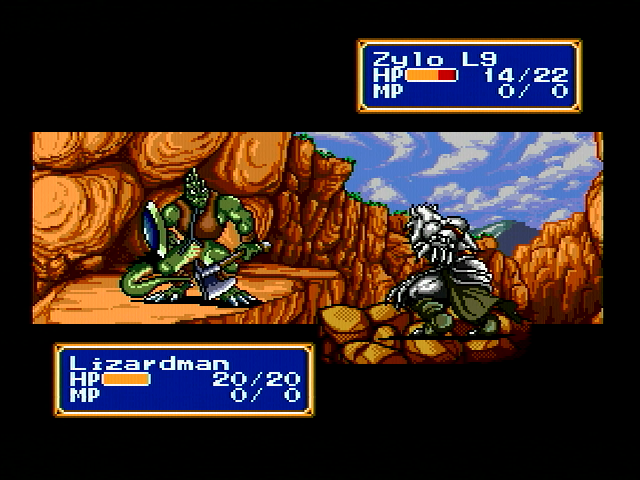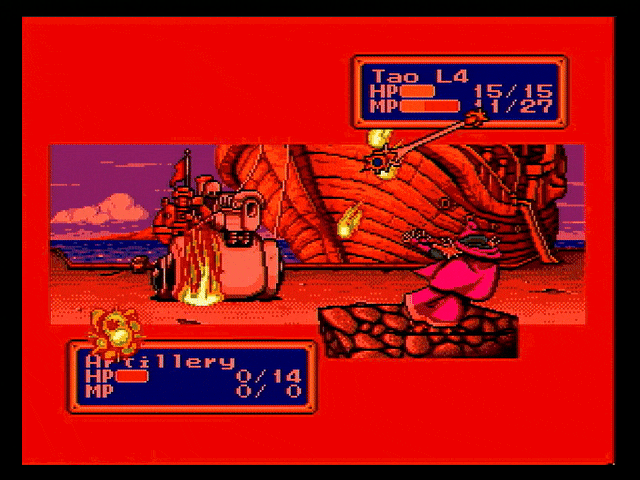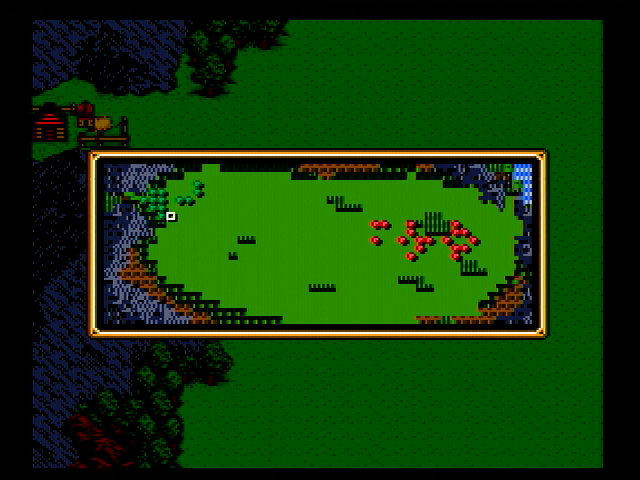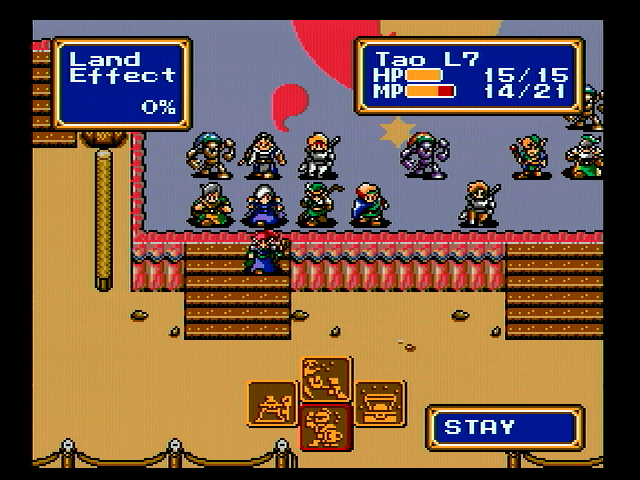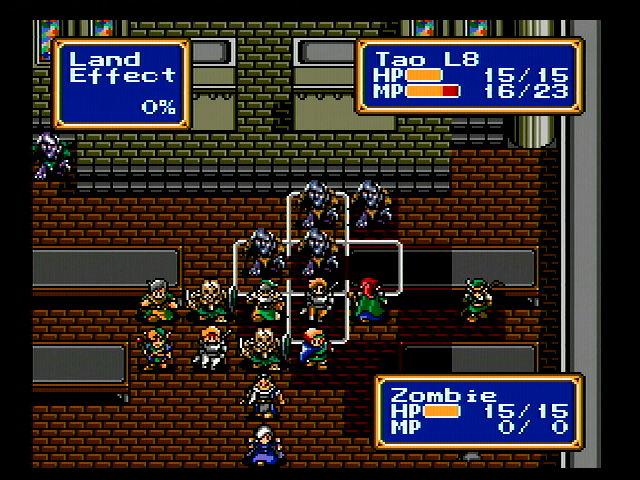Shining Force - Climax Entertainment/Sonic Software Planning - 1992 - First time playing?: Yes!
 Any time I review a turn-based strategy game I always get worried that people are going to overanalyse the screenshots I take in order to judge how terrible my tactics are in spite of how much I say I love the genre.
Any time I review a turn-based strategy game I always get worried that people are going to overanalyse the screenshots I take in order to judge how terrible my tactics are in spite of how much I say I love the genre.
Anyway, Shining Force is a big one, one of the early codifiers of tactical RPGs, a major beloved SEGA classic that I’ve never even touched. Strategy RPGs before Shining Force have absolutely existed, Fire Emblem being the obvious example of one, but Shining Force beat Fire Emblem to having an English translation, in addition to being a user-friendly and accessible introduction to the genre, mixing the tactical combat with exploration of towns, overworlds and interactions with NPCs and shops. Having played through the game now, I’m realising that the influence of Shining Force can be felt especially across SEGA’s future output of SRPGs, especially in the Game Gear hidden gem Royal Stone, which comes highly recommended from me as well. In spite of its age, Shining Force has also aged remarkably well, with intuitive controls, user interfaces and mechanics that keep the game as accessible as it ever was.
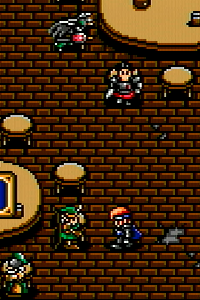 If you’ve played any other JRPG however, very little of Shining Force’s story will excite you. It’s not the kind of thing that gets in the way of the gameplay which remains very solid, but if you’re one of the JRPG players who are primarily in the genre for the stories above anything else, you’ll likely be left cold here. You must prevent the resurrection of Dark Dragon because the Dark Dragon has Dark in his name, which means by JRPG rules that he is a dick. You must use light to save the world. That kinda thing. Even for the time these tropes were pretty tired. You’re likely to see every single attempt at a twist coming a mile away. I can easily say that the likes of Mother 1 and Ys 1 and 2 have much more engaging narratives, and both of those came out in 1989, four years before Shining Force. That’s not to say that Shining Force is without charm however. I consider the tone of Shining quite similar to early Dragon Quest in its light-hearted take on the RPG genre. The colourful fantasy world of the Shining games is quite delightful, featuring all kinds of whimsical fantasy creatures as your allies such as centaurs, werewolves, birdmen, a jellyfish and an alien hamster from the planet Yogurt. As a doll who finds humans the most boring characters to play as in any fantasy RPG, I greatly appreciate the diversity.
If you’ve played any other JRPG however, very little of Shining Force’s story will excite you. It’s not the kind of thing that gets in the way of the gameplay which remains very solid, but if you’re one of the JRPG players who are primarily in the genre for the stories above anything else, you’ll likely be left cold here. You must prevent the resurrection of Dark Dragon because the Dark Dragon has Dark in his name, which means by JRPG rules that he is a dick. You must use light to save the world. That kinda thing. Even for the time these tropes were pretty tired. You’re likely to see every single attempt at a twist coming a mile away. I can easily say that the likes of Mother 1 and Ys 1 and 2 have much more engaging narratives, and both of those came out in 1989, four years before Shining Force. That’s not to say that Shining Force is without charm however. I consider the tone of Shining quite similar to early Dragon Quest in its light-hearted take on the RPG genre. The colourful fantasy world of the Shining games is quite delightful, featuring all kinds of whimsical fantasy creatures as your allies such as centaurs, werewolves, birdmen, a jellyfish and an alien hamster from the planet Yogurt. As a doll who finds humans the most boring characters to play as in any fantasy RPG, I greatly appreciate the diversity.
 There’s also a huge amount of detail and flavour text throughout. Small touches flesh out the world such as the bookshelves littered throughout the game, which can be inspected to see the titles of two of the books on the shelf, often telling you more about the background of the character whose house you’re currently in and giving more breadcrumbs about the lore and larger picture of the story. NPCs also frequently have entirely new dialogue if you talk to them after major battles take place, giving the sense that your actions are having a genuine impact on the world. One of my favourite details I noticed is that when you’re on a boat, if you go down into the cabin you can find a makeshift headquarters where every single playable character has unique dialogue that isn’t said in any other headquarters in the game. There is however, unfortunately the constant lingering question of how much of this flavour text is even relevant to the original Japanese script, as the translation is, well…
There’s also a huge amount of detail and flavour text throughout. Small touches flesh out the world such as the bookshelves littered throughout the game, which can be inspected to see the titles of two of the books on the shelf, often telling you more about the background of the character whose house you’re currently in and giving more breadcrumbs about the lore and larger picture of the story. NPCs also frequently have entirely new dialogue if you talk to them after major battles take place, giving the sense that your actions are having a genuine impact on the world. One of my favourite details I noticed is that when you’re on a boat, if you go down into the cabin you can find a makeshift headquarters where every single playable character has unique dialogue that isn’t said in any other headquarters in the game. There is however, unfortunately the constant lingering question of how much of this flavour text is even relevant to the original Japanese script, as the translation is, well…
 I'm used to JRPGs of this era being borderline incoherent due to poor translations, so Shining Force is far from the worst I've seen on the system. Try Soleil to see the worst of the worst the console has to offer translation-wise. The game is at least generally spell checked and grammatically correct, with a few exceptions, but there's still a lot of dialogue that just doesn't quite add up. Characters will say contradictory things, expect you to already know plot points that have never been brought up before and leave many questions unanswered. The reason for this is that the English script is heavily abridged, condensing dialogue heavily and leaving out entire text boxes worth of dialogue. As a result, the dialogue is much more blunt with much less personality. There's also strange instances where the localisation just, well, makes things up. You don't even have to get into spoilers for this, it happens in the intro. Shining Force has a cute framing device in which an elven child is reading a storybook with the player, who you interact with through dialogue in order to access menu functions such as starting a new game or loading save data. The implication is that the events of the game all take place in this storybook you're reading with her, unless you're playing the localised version, in which the child starts reading the book, then takes it at face value and believes it's an actual doomsday prophecy which she begs the player character to go and prevent. Here, the framing device is instead that the protagonist forms the Shining Force and goes to war because a child that never appears anywhere else in the game tells him about a dragon in the book she's reading. The further you play, the more issues this framing device causes and the more incoherent it becomes.
I'm used to JRPGs of this era being borderline incoherent due to poor translations, so Shining Force is far from the worst I've seen on the system. Try Soleil to see the worst of the worst the console has to offer translation-wise. The game is at least generally spell checked and grammatically correct, with a few exceptions, but there's still a lot of dialogue that just doesn't quite add up. Characters will say contradictory things, expect you to already know plot points that have never been brought up before and leave many questions unanswered. The reason for this is that the English script is heavily abridged, condensing dialogue heavily and leaving out entire text boxes worth of dialogue. As a result, the dialogue is much more blunt with much less personality. There's also strange instances where the localisation just, well, makes things up. You don't even have to get into spoilers for this, it happens in the intro. Shining Force has a cute framing device in which an elven child is reading a storybook with the player, who you interact with through dialogue in order to access menu functions such as starting a new game or loading save data. The implication is that the events of the game all take place in this storybook you're reading with her, unless you're playing the localised version, in which the child starts reading the book, then takes it at face value and believes it's an actual doomsday prophecy which she begs the player character to go and prevent. Here, the framing device is instead that the protagonist forms the Shining Force and goes to war because a child that never appears anywhere else in the game tells him about a dragon in the book she's reading. The further you play, the more issues this framing device causes and the more incoherent it becomes.
 However, this does give me a chance to plug a fellow Neocities page. If you’re curious about the changes in the script and all the extra lore that was just entirely skipped over, I highly recommend checking out Claire’s Shining Force Library. Claire absolutely adores the Shining series and has detailed a ton of information about everything Shining that was lost in translation. They have retranslated the major plot scenes of Shining Force 1, so as I played through the game I was constantly cross-referencing dialogue with Claire’s retranslated script to make sure I didn’t miss anything. The site’s not just retranslations either, it also details material such as Shining guide books and novels that were never released outside of Japan in any form. It’s a great read and full of all kinds of information I never even knew was out there.
However, this does give me a chance to plug a fellow Neocities page. If you’re curious about the changes in the script and all the extra lore that was just entirely skipped over, I highly recommend checking out Claire’s Shining Force Library. Claire absolutely adores the Shining series and has detailed a ton of information about everything Shining that was lost in translation. They have retranslated the major plot scenes of Shining Force 1, so as I played through the game I was constantly cross-referencing dialogue with Claire’s retranslated script to make sure I didn’t miss anything. The site’s not just retranslations either, it also details material such as Shining guide books and novels that were never released outside of Japan in any form. It’s a great read and full of all kinds of information I never even knew was out there.
 As for the gameplay, it is a mixture of large-scale turn-based battles broken up with Dragon Quest-style top down exploration. In between battles you can explore towns and the overworld, find hidden items, talk to NPCs, recruit new party members and buy and sell items at shops. The controls are bizarrely delayed in the towns and I have no idea why, considering that movement is snappy and responsive literally everywhere else in the game, but I suppose it’s not a huge issue in a game that’s turn-based. You might expect these sections to be more a vehicle for dialogue and story progression as opposed to actual gameplay like the battles are, but with how much you are rewarded for exploring thoroughly and inspecting everything, exploring the towns is actually extremely fun and rewarding. The previously mentioned attention to detail really shines through here and there’s a ton of opportunities to find and recruit secret party members that you can easily miss, making them feel all the more rewarding to discover. That funny alien hamster I mentioned? Yeah, I completely missed him in my playthrough, I only knew he existed because I had heard about him online prior to even playing the game. The unlock condition for Domingo was my favourite out of the party members I managed to find myself, which requires you to find a hidden egg early in the game and bring it to an NPC who can hatch it later. It was satisfying to discover the purpose of that weird item I couldn’t figure out a use for back when I first got it, especially as the reward is one of the best party members in the game.
As for the gameplay, it is a mixture of large-scale turn-based battles broken up with Dragon Quest-style top down exploration. In between battles you can explore towns and the overworld, find hidden items, talk to NPCs, recruit new party members and buy and sell items at shops. The controls are bizarrely delayed in the towns and I have no idea why, considering that movement is snappy and responsive literally everywhere else in the game, but I suppose it’s not a huge issue in a game that’s turn-based. You might expect these sections to be more a vehicle for dialogue and story progression as opposed to actual gameplay like the battles are, but with how much you are rewarded for exploring thoroughly and inspecting everything, exploring the towns is actually extremely fun and rewarding. The previously mentioned attention to detail really shines through here and there’s a ton of opportunities to find and recruit secret party members that you can easily miss, making them feel all the more rewarding to discover. That funny alien hamster I mentioned? Yeah, I completely missed him in my playthrough, I only knew he existed because I had heard about him online prior to even playing the game. The unlock condition for Domingo was my favourite out of the party members I managed to find myself, which requires you to find a hidden egg early in the game and bring it to an NPC who can hatch it later. It was satisfying to discover the purpose of that weird item I couldn’t figure out a use for back when I first got it, especially as the reward is one of the best party members in the game.
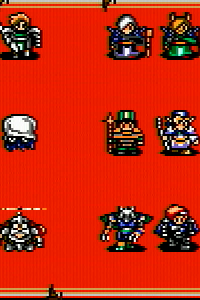 Items found in treasure chests in these exploration segments are similarly helpful. Not only can you find unique weapons and equipment that can’t be found anywhere else, but there’s also a variety of consumable items that permanently increase a selected party member’s base stats upon use. In addition to the stat boosts obviously being welcome, this also allows a little extra customisation in how you build your party, breaking away from the linear character growth of simply leveling up. Do you give that defence potion to one of your healers who critically needs to stay alive in order to support the rest of the team, or do you instead give it to one of your knights who are far more likely to be taking damage due to fighting on the frontlines?
Items found in treasure chests in these exploration segments are similarly helpful. Not only can you find unique weapons and equipment that can’t be found anywhere else, but there’s also a variety of consumable items that permanently increase a selected party member’s base stats upon use. In addition to the stat boosts obviously being welcome, this also allows a little extra customisation in how you build your party, breaking away from the linear character growth of simply leveling up. Do you give that defence potion to one of your healers who critically needs to stay alive in order to support the rest of the team, or do you instead give it to one of your knights who are far more likely to be taking damage due to fighting on the frontlines?
On the topic of characters, there’s a ton to choose from, 30 in total. You can only have 12 characters in your party at a time, including the protagonist who must be in the party at all times, so it’s important to consider what party members you take to battle, aiming for a balanced team that’s capable of dealing with every possible threat the game throws at you and is also suitable for backing up your fellow teammates. It’s somewhat akin to monster collecting games like Pokemon, where you can swap out characters at any time and reassemble your team, but you’ll end up focusing on a select few favourites to ensure they get the exp and levels they need to carry you through the game. Personally, I made sure to include any magic users I could, thanks to them having powerful multitarget skills that really help with dealing with the larger hordes certain maps throw at you. For melee frontliners, I mainly used centaur knights, who in addition to being quite tanky and dealing good close-range damage, can also use spears which have a bit more range to them, allowing you to hit enemies from a distance of two tiles. For pure melee however, I used Zylo, a werewolf berserker who can’t equip weapons but absolutely makes up for it with great stat boosts on level ups, good speed and high defence.
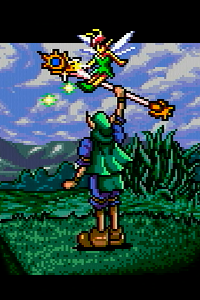 When it comes to strategy RPGs, I find that there’s often a struggle to nail that balance of RPG style character building and progression alongside the strategic gameplay that takes place in the battles. For instance, as much as I love Disgaea, it absolutely falls into a trap where battle tactics don’t feel nearly as important or valuable as simply leveling up and making your characters as overpowered as possible. This isn’t inherently a bad thing as much as it just means that the focus of the game is diverted from the battle tactics, so you’re not getting the same level of strategy gameplay you experience in a tactics game without RPG elements, such as Nectaris or Advance Wars.
When it comes to strategy RPGs, I find that there’s often a struggle to nail that balance of RPG style character building and progression alongside the strategic gameplay that takes place in the battles. For instance, as much as I love Disgaea, it absolutely falls into a trap where battle tactics don’t feel nearly as important or valuable as simply leveling up and making your characters as overpowered as possible. This isn’t inherently a bad thing as much as it just means that the focus of the game is diverted from the battle tactics, so you’re not getting the same level of strategy gameplay you experience in a tactics game without RPG elements, such as Nectaris or Advance Wars.
Shining Force, in my opinion, gets the balance down pretty well. Battles in Shining Force aren’t infinite, they only happen at specific points in the story, so once they’re defeated you can’t replay them, giving the battles a fairly linear level-by-level progression and limiting the opportunities for grinding. As a result, there’s a constant element of risk and reward when it comes to leveling up weaker party members, since opportunities to do so aren’t always frequent. Healers for instance don’t gain much experience from using healing magic, so if you want to level them up faster and get better support spells, you’re going to need them to get into combat, or else you’ll end up like I did with your healers only learning the Level 3 heal spell at the final boss. Also of consideration is the fact that if your protagonist dies in battle, it’s an instant game over. Sending him out to the frontlines is risky as a result and can prematurely end a battle poorly, but he remains worth using and leveling up so he can defend himself if an enemy manages to sneak past your frontliners and attack the protagonist directly. Part of the strategy becomes manufacturing situations in which these more vulnerable characters get a chance to safely get some kills for greater exp gains. For instance, luring a single enemy unit away from the larger group of enemies, softening them up and then letting a healer finish them off with a melee attack..
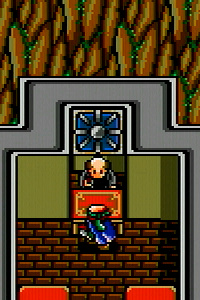 There is still a way to grind if you feel the need to, however. You can use the magic spell Egress mid-battle to instantly warp back to the nearest town while keeping all experience gained across all party members. If you are killed in battle, that also sends you back to the last town as well. As such, any time you fail to complete a battle, you have a bit more experience gained from your previous attempt to help you try again and have an extra advantage, essentially creating a dynamic difficulty system where the game becomes easier the more you struggle to progress. This obviously could be exploited if you’re dead set on grinding, but I don’t doubt that the game would become much duller as a result. I died a few times in Shining Force but overall I found the difficulty pretty relaxed. It never felt like my issue was that I was underleveled as much as it was that my strategy was bad, which is how I prefer it personally.
There is still a way to grind if you feel the need to, however. You can use the magic spell Egress mid-battle to instantly warp back to the nearest town while keeping all experience gained across all party members. If you are killed in battle, that also sends you back to the last town as well. As such, any time you fail to complete a battle, you have a bit more experience gained from your previous attempt to help you try again and have an extra advantage, essentially creating a dynamic difficulty system where the game becomes easier the more you struggle to progress. This obviously could be exploited if you’re dead set on grinding, but I don’t doubt that the game would become much duller as a result. I died a few times in Shining Force but overall I found the difficulty pretty relaxed. It never felt like my issue was that I was underleveled as much as it was that my strategy was bad, which is how I prefer it personally.
Another risk to consider is the promotion mechanic. Once a character hits level 10, they’re able to be promoted to an upgraded class via the chapels in each town. Promoted units are capable of gaining even more stat boosts on level ups, using stronger weaponry and getting new designs and attack animations in battle. However, upon promotion, your unit’s stats are reduced by 15%. The ensuing stat gains more than make up for this minor setback, but it’s also just enough of a setback to leave your unit much more vulnerable against enemies of increasing strength. Another mistake I made was promoting nearly half of my party all at once. Um, don’t do that. You’ll want units without stat penalties to be able to back up the freshly promoted ones until they catch up. Seeing the cool new animations sure makes me want to promote everyone as soon as possible though. I absolutely love the mage’s spell casting animation after promotion, nothing is more satisfying than seeing Tao throw her staff up in the air and unleash hellfire upon a large group of enemies from the palms of both of her hands. Click the image below to see that animation in action, however I also want to give an epilepsy warning for flashing lights, which is why I didn't just embed the gif into this page like normal.
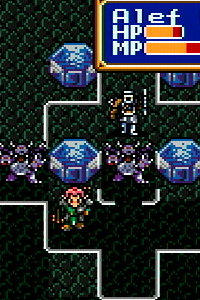 The battle system itself is fairly standard grid-based turn-based tactical combat. Characters take turns dependent on their speed stat and act by traversing as much ground as their movement stats allows for, attacking, using magic or items. Many of the basic hallmarks of the genre are present, such as terrain effects, creating defensive formations, keeping your ranged units guarded and gradually covering more ground as you aim to take out as many enemies with the most minimal risks of harm to your party and loss of resources. Overall, it’s actually quite simple as far as strategy games go, but by no means unengaging. I find the satisfaction of Shining Force’s combat comes from seeing how each unit plays off of each other and learning more about how your dream team can effectively operate and use all of its abilities to their max potential, which is something you’ll gradually and naturally get more and more of a feel for as you play through more battles and figure out what units are your favourites.
The battle system itself is fairly standard grid-based turn-based tactical combat. Characters take turns dependent on their speed stat and act by traversing as much ground as their movement stats allows for, attacking, using magic or items. Many of the basic hallmarks of the genre are present, such as terrain effects, creating defensive formations, keeping your ranged units guarded and gradually covering more ground as you aim to take out as many enemies with the most minimal risks of harm to your party and loss of resources. Overall, it’s actually quite simple as far as strategy games go, but by no means unengaging. I find the satisfaction of Shining Force’s combat comes from seeing how each unit plays off of each other and learning more about how your dream team can effectively operate and use all of its abilities to their max potential, which is something you’ll gradually and naturally get more and more of a feel for as you play through more battles and figure out what units are your favourites.
The enemy AI is… unusual. At first I thought it was surprisingly intelligent, as I realised early on that it was common for enemy units to retreat in order to regroup with larger hordes. Other times though it’s bafflingly dense or just completely unaware of its surroundings. Especially near the endgame I frequently ran into enemies not being able to tell I was right next to them and attacking them as long as I just positioned myself diagonally next to them as opposed to one of the four cardinal directions. When that enemy unit’s turn comes they just pass as if there’s nothing to gain from attacking or retreating. Even a few bosses ended up doing this. At the same time, there is a level of unpredictability that comes from how all over the place the AI is which can keep you on your toes. They’re also smart enough to know that your protagonist is the highest priority, so they’ll go out of their way to target him if he’s left vulnerable. Incidentally, killing the boss in a battle is an instant win condition, just like how your protagonist getting killed is an instant loss for you. You miss out on exp this way of course but it’s still satisfying to pull through a difficult map with few units by quickly whacking the head of operations.
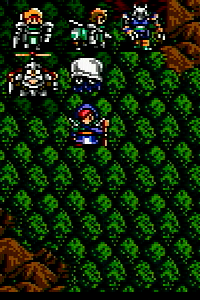 If there’s any part of Shining Force that wears me down though, it’s the overworld battles. Towns are connected together by large plains akin to world maps in RPGs like Dragon Quest and Final Fantasy, and at certain points of the story you’ll be required to fight enemy armies on said overworld maps. These are an absolute slog most of the time, the maps are so massive and empty that you’re spending half of the battle just slowly moving your units one by one to the other side of the map where all the enemies are, with nothing happening for turn after turn. This would already be bad enough, but the overworlds are also full of rocky terrain and thick forests that cut your movement speed in half, making traversing the map even slower. The enemies here are often fairly weak as well, resulting in these battles feeling like tedious filler in an otherwise superbly paced game. Making things even worse, sometimes you’ll run into multiple different battles taking place on the exact same overworld map, generally if progression requires you to return to an earlier town again. The enemies are of course different, but it’s still hard to not feel deja vu.
If there’s any part of Shining Force that wears me down though, it’s the overworld battles. Towns are connected together by large plains akin to world maps in RPGs like Dragon Quest and Final Fantasy, and at certain points of the story you’ll be required to fight enemy armies on said overworld maps. These are an absolute slog most of the time, the maps are so massive and empty that you’re spending half of the battle just slowly moving your units one by one to the other side of the map where all the enemies are, with nothing happening for turn after turn. This would already be bad enough, but the overworlds are also full of rocky terrain and thick forests that cut your movement speed in half, making traversing the map even slower. The enemies here are often fairly weak as well, resulting in these battles feeling like tedious filler in an otherwise superbly paced game. Making things even worse, sometimes you’ll run into multiple different battles taking place on the exact same overworld map, generally if progression requires you to return to an earlier town again. The enemies are of course different, but it’s still hard to not feel deja vu.
 Thankfully the battles in dungeons are far more interesting, varied and tightly designed. The enemy formations and positioning alongside the more intricate level design is far more engaging and fun. Enemies here are often much more aggressive in contrast to how passive and uninterested they seem in the overworld. Flying enemies will go out of their way to try and ambush your protagonist, stronger enemies who are seemingly out of line of sight will start actively approaching you to back up smaller armies you’re currently fighting, enemy magic users are better placed to support their allies, so on and so forth. Many of these dungeon battles also feature bosses, giving the battle more of a satisfying escalation to a big climax as opposed to just fizzling out when you kill the last common enemy. They even worked the exploration elements of the towns into the dungeons, with plenty of treasure chests to find with valuable items inside. The dungeons absolutely represent the best of Shining Force’s battle design and are consistently fun and engaging.
Thankfully the battles in dungeons are far more interesting, varied and tightly designed. The enemy formations and positioning alongside the more intricate level design is far more engaging and fun. Enemies here are often much more aggressive in contrast to how passive and uninterested they seem in the overworld. Flying enemies will go out of their way to try and ambush your protagonist, stronger enemies who are seemingly out of line of sight will start actively approaching you to back up smaller armies you’re currently fighting, enemy magic users are better placed to support their allies, so on and so forth. Many of these dungeon battles also feature bosses, giving the battle more of a satisfying escalation to a big climax as opposed to just fizzling out when you kill the last common enemy. They even worked the exploration elements of the towns into the dungeons, with plenty of treasure chests to find with valuable items inside. The dungeons absolutely represent the best of Shining Force’s battle design and are consistently fun and engaging.
An additional thing I have to give credit to is the user interface. Shining Force has one of the slickest menu systems of any JRPG series of the era I can name. When navigating menus, every option available to the player is mapped to a direction on the d-pad. If you want to select the northmost option in the menu, you press up on the d-pad and it’s immediately highlighted for you to select with the A button. All of these menus are conveyed with animated icons allowing for a quick visual representation of what each option does as well. I’m not going to act like cycling through lists of options in other JRPGs is tedious enough for it to need to be streamlined, and I don’t doubt that Shining Force’s setup would not work in more complex games where you’ll need more than four options at any time, but it works wonderfully for Shining Force itself and makes commands like going into a magic menu and selecting the spell you want to cast feel fast and intuitive. I can say immediately that Tao casts her fire magic by opening the menu, pressing left on the d-pad to select magic and then pressing up on the d-pad to select fire, whereas I couldn’t list off the button inputs to access Cure in Final Fantasy by memory nearly as easily, which requires remembering where it is positioned in a list and how many button taps it takes to reach it.
In spite of the qualms I’ve mentioned, alongside some other nitpicks like inventory management being a bit of a hassle due to having to juggle items between party members a lot, I really do stand by Shining Force holding up very well to this day. In addition to solid and rewarding gameplay, the presentation is also superb with charming character designs and plenty of large detailed sprites used for battle animations, even if a few of the battle sprites are disappointingly reused among characters in the same class. I’d consider it a good entry point for the genre as well, it’s pretty gentle difficulty wise and doesn’t incorporate any intimidating mechanics common to strategy RPGs of the era such as permadeath. There’s still room for improvement of course, so I’ll be looking forward to trying the sequels and spinoffs in the future as well.
Page written by MSX_POCKY, 22nd September 2024




